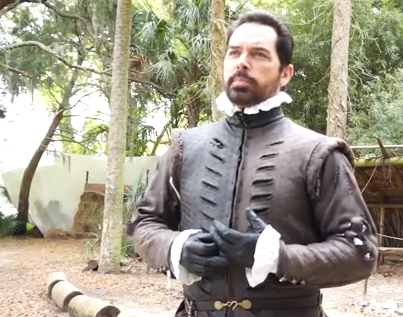By Justin Katz | gargoyle@flagler.edu
Video by Justin Katz and Emily Topper
Chad Light has spent most of his life living in the past.
Light has made his name, and face, famous around St. Augustine by portraying Pedro Menéndez de Avilés, the Spanish founder of St. Augustine, at the Fountain of Youth Park.
Light’s most popular appearance is at the annual celebration of the city’s founding every September. Light and an army of other re-enactors recreate the day that Menéndez first landed in Florida.
Although many tourists look at Light’s job as a hobby, he has made re-enacting his life’s work.
“I’m 47 years old and I’ve been doing this consciously for 43 years,” Light said.
Light’s involvement with historical re-enacting began when he was young. His father, a professor at the College of William and Mary, was interested in the French and Indian War. Living in close proximity to historical locations like Jamestowne and Williamsburg, Light and his father both portrayed 16th, 17th and 18th century Englishmen.
“It’s not a nine to five job. I’m one of the few people lucky enough to make my living like this,” said Light.
Light’s work requires him to be immersed in Menéndez. He has read The Enterprise of Florida, written by Eugene Lyon, Ph.D., adjunct instructor of history at the University of Florida, over 30 times since he was asked to portray Menéndez three years ago.
Light also needs to look the part. His clothing, which can’t be machine washed or dry-cleaned, is all hand-made by a tailor. However, the most difficult part of his job is keeping his composure. Tourists are not always polite or informed.
“I’m constantly surprised by the general ignorance of the population,” Light said. “If we’re not wearing modern clothes, they’ll think we’re pirates.”
Jake Harper, director of historical programming at the Colonial Quarter, a downtown tourist attraction that hosts events about the city’s history, understands this ignorance all too well.
“When I used to work at the fort I would stand out front on guard duty and people would ask me if the fort was real or not,” Harper said.
Harper believes that some tourists are ignorant because they have never experienced history in a tangible fashion. Light admits the population’s ignorance gets on his nerves occasionally but, as a representative of the city and the state, he remains professional.
“These are good people that are spending their money to come down here and they’re just looking for a good time,” Light said.
Light feels a sense of connection with his work. His desire to connect with his ancestors is something that many re-enactors also seek to capture.
Craig Diadus, a re-enactor with Native American heritage, also seeks to establish a connection with his ancestors through personally making the artifacts and tools that the local native population used in the area before European settlement.
Diadus has also experienced ignorance. Most tourists have a vague idea of Native American history often involving teepees and tomahawks.
“History is what you make of it, and it’s nobody’s fault, but most people just don’t have a good grasp of history,” Diadus said. “This [re-enacting] makes people understand it a little bit easier.”
But regardless of the time period they are portraying, Diadus, Harper and Light all share a common goal.
“These people are passionate about finding out who they are and why everything is the way it is because that’s our history and it’s everyone’s history,” Light said. “We’re just trying to make ours count.”



Be the first to comment on "Local re-enactors provide insight into the past"